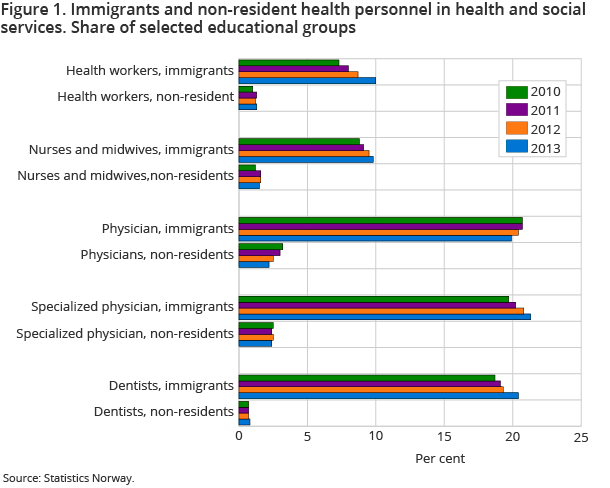Content
Published:
This is an archived release.
Increase in employees with health care education
Figures for the 4th quarter of 2013 show that a total of 378 700 persons with a health care education are employed; an increase of 2.6 per cent or nearly 9 700 persons compared to 2012.
| 2013 | 2012 - 2013 | 2012 | ||
|---|---|---|---|---|
| Total | Share | Per cent | Total | |
| Persons with a health care education | 427 769 | 100.0 | 2.3 | 417 970 |
| Men | 64 628 | 15.1 | 2.7 | 62 913 |
| Women | 363 141 | 84.9 | 2.3 | 355 057 |
| Employed persons with a health care education | 370 211 | 100.0 | 2.4 | 361 455 |
| Men | 58 279 | 15.7 | 2.5 | 56 867 |
| Women | 311 932 | 84.3 | 2.4 | 304 588 |
| Employed persons with a health care education in health and social services | 292 720 | 79.1 | 2.1 | 286 696 |

In the health and social services, a total of 298 800 persons with a health care education were employed, with a total of 254 000 man-years. This is an increase of 2.3 per cent or nearly 6 600 persons since 2012.
Almost 32 800 immigrants and non-resident health personnel were working in health and social services in 2013. Immigrants constitute 90 per cent of this group. Nurses are the largest group, with a total of almost 10 000 persons, while physicians were the second largest group with 4 900 persons.
New increase in health workers
Similar to the preceding years, the number of educated and authorised health workers shows the largest increase, with an increase of more than 4 700 persons.
Women make up 84 per cent of health and care personnel
With few exceptions, women dominate most types of health education. Only six types of health care education in these statistics consist of more men than women. This applies to specialists in dentistry, specialised physicians, ambulance workers, chiropractors, perfusionists and orthopaedic engineers. In education for medical secretaries, dental secretaries, dental nurses, health visitors and midwives, women totalled over 99 per cent.
A majority in public administration
Almost 79 per cent of employed persons with a health care education work within health and social services. Almost half of the group works within municipal health services, while 31 per cent work within the governmental sector; mainly in the health enterprises. These figures are unchanged from 2012.
One in ten have more than one job
Having more than one job is relatively common among health personnel, with almost one in ten having more than one job. More than 20 per cent of specialised physicians have more than one job.
The average working hours for employed persons with a health care education in health and social services were 31.3 hours in the 4th quarter of 2013. This is at the same level as the preceding years.
Contact
-
Arbeidsmarked og lønn
E-mail: arbeidsmarked@ssb.no
-
Fredrik Steinrem Edelmann
E-mail: fredrik.edelmann@ssb.no
tel.: (+47) 40 90 24 60
-
Sophie Sæternes
E-mail: sophie.saeternes@ssb.no
tel.: (+47) 98 67 14 26
-
Stine Bakke
E-mail: stine.bakke@ssb.no
tel.: (+47) 91 52 62 51
